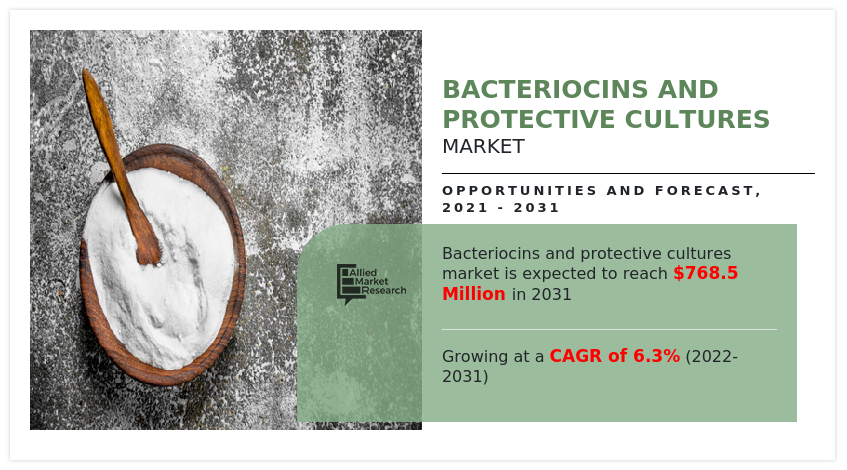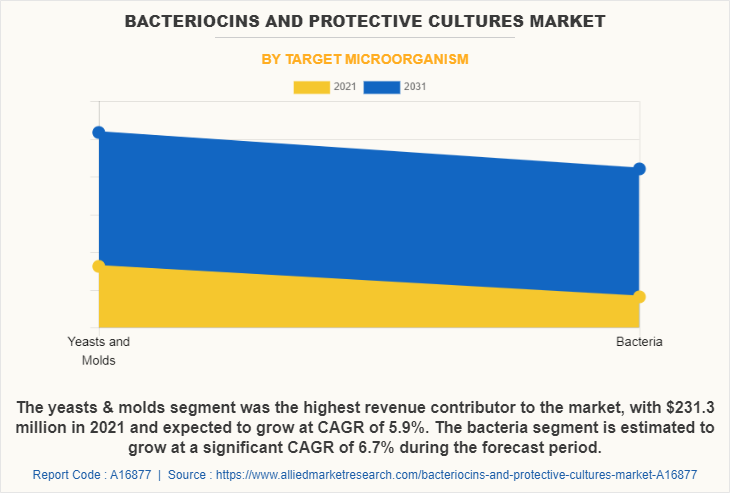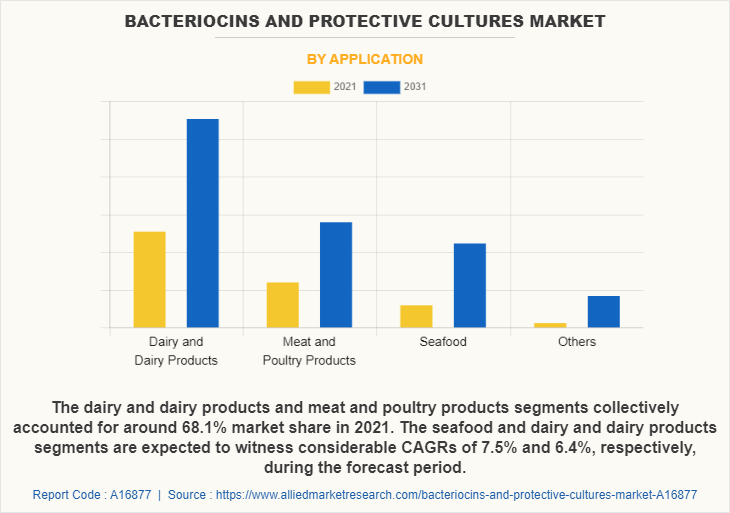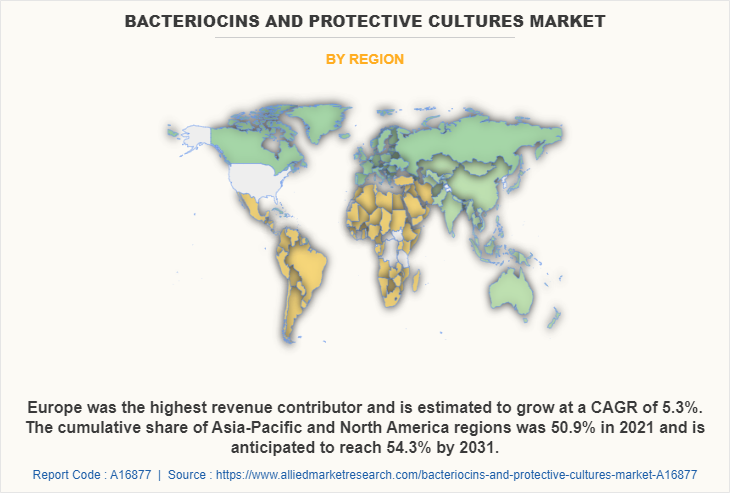The global bacteriocins and protective cultures market was valued at $421.3 million in 2021, and is projected to reach $768.5 million by 2031, growing at a CAGR of 6.3% from 2022 to 2031.
Controlled micro flora applications employ protective cultures (PCs), which are antagonistic to specific food poisoning or spoiling organisms. There are a few commercialized antifungal protection cultures, and their uses are still developing, particularly for dairy products, but also for other foods and feeds. Despite the fact that there hasn't been much research in this area, antifungal cultures have become more important for cheese applications. The assessment of cheese deterioration by yeasts and molds is challenging because, depending on the kind of cheese and microorganisms, fungal activity during ripening can either be beneficial or detrimental to product quality. Bacteriocins serve as a bacterial immunological defense mechanism. Bacteriocin-producing bacteria have the ability to restrict the growth of sensitive bacteria by releasing a variety of bacteriocins, which can be produced by both gram-positive and gram-negative bacteria. Proteins or peptides known as bacteriocins are produced by the ribosome. It can combine with the appropriate receptor on the surface of the sensitive bacteria when released by bacteriocin-producing bacteria to destroy the bacteria.
Many food experts and scientists do not favor the use of artificial and chemical preservatives to lengthen the shelf life of certain food products. Many scientists believe that the application of protective cultures is superior and secure, since it naturally extends the shelf life of food and beverage items. Protective cultures in food and drink are expected to draw a sizable consumer base during the forecast period as a result of this feature. Thus, the bacteriocins and protective cultures market demand is anticipated to increase due to the expanding dairy and meat products.
Due to the need to reduce the risks of post-processing contamination and L. monocytogenes growth in RTE deli meats, the use of protective cultures in processed meat and poultry products has recently become a major research topic. So many researches have shown a wide range of strains from different LAB species as effective protection cultures for cured grilled foods. Thus, growth in demand for processed meat and poultry products is projected to generate more demand for bacteriocins and protective culture during the forecast period. Furthermore, rise in demand for natural food preservative based products and surge in adoption of a healthy lifestyle are anticipated to garner the growth of the bacteriocins and protective cultures industry.
Rise in working population has led to high demand for conventional food, packaged food, and ready-to-eat food due to busy & hectic schedule. These food are designed for ease of consumption, such as shelf-stable products, refrigerated or frozen products, and dry mixes, which require minimal preparation and others. Further, the bacteriocins and protective cultures market is expected to be driven by high demand for conventional and ready-to-eat food, as these food contain various additives and preservations such as anti-caking, emulsifiers, gelling & thickening, and sweeteners. Natural preservatives including bacteriocins and protective cultures are added to food to maintain the quality and to reduce the spoilage by various microorganisms such as foodborne infections, UV-C radiation, and others.

According to the bacteriocins and protective cultures market analysis, the bacteriocins and protective cultures market is segmented into target organism, application and region. On the basis of target organism, the bacteriocins and protective cultures market is categorized into yeasts & molds and bacteria. By application, it is segmented into dairy and dairy products, meat and poultry products, seafood and others. On the basis of region, it is analyzed across North America (the U.S., Canada, and Mexico), Europe (Germany, France, UK, Italy, Spain, Russia and Rest of Europe), Asia-Pacific (China, Japan, India, Australia, South Korea and Rest of Asia-Pacific), and LAMEA (Brazil, Argentina, UAE, Turkey, South Africa and Rest of LAMEA).
According to the bacteriocins and protective cultures market trends, on the basis of target organism, the yeast and molds segment was the highest contributor to the bacteriocins and protective cultures market size, with $231.3 million in 2021, and is estimated to reach $408.1 million by 2031, at a CAGR of 5.9% during the forecast period. Bacteriocins are often mixed in with other antimicrobial compounds in food products and can be added as semi-purified compounds or in the form of bioactive powders. Yeasts, molds, and Gram-positive or Gram-negative bacteria can all be controlled with bacteriocins and protective cultures. Food packaging films can also contain bacteriocins to prevent food spoiling or harmful microbial growth while the food is being stored. Thus, above factors are likely to propel the bacteriocins and protective cultures market growth through yeast and molds segment during forecast period.

According to application, the seafood segment was the significant contributor to the market, with $177.1 million in 2021 and is expected grow at a CAGR of 6.4% during the forecast period. The protective cultures and bacteriocins are used in dairy and dairy products, meat and poultry products, seafood, and others. The sector of dairy and dairy products held a bigger market share in 2021, but the category of seafood is anticipated to grow at a faster rate over the forecast period. Cheese is one of the many goods included in the category of dairy and dairy products. Protective cultures are increasingly used since they are generally regarded as safe (GRAS) for eating and naturally predominate in the microbiota of many commodities, particularly in the dairy, meat, and seafood industries.

According to the bacteriocins and protective cultures market opportunities, region wise, North America garnered the considerable bacteriocins and protective cultures market share in 2021, and is expected to maintain its market share throughout bacteriocins and protective cultures market forecast period. North America has significantly increased its market share for bacteriocins and protective cultures in 2021. This is mostly related to rise in demand for natural preservatives and long-lasting food and beverages. Due to changes in lifestyle, consumers in this region are more interested in using natural preservatives to keep food safe and nutritious. In addition, it has encouraged market participants to spend money on organically created bio-preservatives. Bacteriocins and protective culture production are anticipated to increase in North America as a result of increased investment in R&D activities and technical advancements.

The players operating in the global bacteriocins and protective cultures industry have adopted various developmental strategies to expand their market share, increase profitability, and remain competitive in the market. The key players profiled in this report Aristomenis D. Phikas and Co SA., Biochem S.R.L, CHR. HANSEN HOLDING A/S, Dalton Biotecnologie S.r.l, DSM, M Food Group GMBH, Proxis Développement, Puratos Group NV, Sacco S.R.L and Soyuzsnab Group of Companies.
Key Benefits For Stakeholders
- This report provides a quantitative analysis of the market segments, current trends, estimations, and dynamics of the bacteriocins and protective cultures market analysis from 2021 to 2031 to identify the prevailing bacteriocins and protective cultures market opportunities.
- The market research is offered along with information related to key drivers, restraints, and opportunities.
- Porter's five forces analysis highlights the potency of buyers and suppliers to enable stakeholders make profit-oriented business decisions and strengthen their supplier-buyer network.
- In-depth analysis of the bacteriocins and protective cultures market segmentation assists to determine the prevailing market opportunities.
- Major countries in each region are mapped according to their revenue contribution to the global market.
- Market player positioning facilitates benchmarking and provides a clear understanding of the present position of the market players.
- The report includes the analysis of the regional as well as global bacteriocins and protective cultures market trends, key players, market segments, application areas, and market growth strategies.
Bacteriocins and Protective Cultures Market Report Highlights
| Aspects | Details |
| Market Size By 2031 | USD 768.5 million |
| Growth Rate | CAGR of 6.3% |
| Forecast period | 2021 - 2031 |
| Report Pages | 233 |
| By Target Microorganism |
|
| By Application |
|
| By Region |
|
| Key Market Players | Puratos Group NV, Aristomenis D. Phikas and Co SA., Dalton Biotecnologie S.r.l, CHR. HANSEN HOLDING A/S, Soyuzsnab Group of Companies, Biochem S.R.L, DSM, Sacco S.R.L, M Food Group GMBH, Proxis Développement |
Analyst Review
Top CXOs believe that research and development is essential for the bacteriocins and protective culture market to expand in terms of value sales. Increase in consumer demand for different processed meat and populatry products and dairy & dairy products has given producers the opportunity to create bacteriocins and protective culture. According to CXOs, rise in health awareness and customer inclination toward healthy lifestyle, and increase in demand for clean label and organic food products are expected to boost the demand for bacteriocins and protective culture. As consumer preference for clean label products rises, the bacteriocins and protective culture market is expanding at a moderate rate. In addition, the market has grown tremendously due to quick development of the organized retail sector and the spike in demand for packaged and convenient health food products. The largest market share for bacteriocins and protective culture is projected to come from Europe. This is linked to a higher uptake of nutritious food as a result of growing public knowledge of the negative effects of artificial food preservatives. Big firms operating globally, like Aristomenis D. Phikas and Co SA., Biochem S.R.L., and CHR. HANSEN HOLDING A/S, continue to dominate the bacteriocins and protective culture market. These companies controlled significant market share globally.
2021 is the base year calculated in the bacteriocins and protective cultures market report.
The global bacteriocins and protective cultures market size was valued at $421.3 million in 2021, and is estimated to reach $768.5 million by 2031.
6.3% is the CAGR of bacteriocins and protective cultures market.
You can request sample from the website (www.alliedmarketresearch.com) or you can call our sales representative on U.S. - Canada toll free - +1-800-792-5285, Int'l : +1-503-894-6022 and for Europe region + 44-845-528-1300.
Aristomenis D. Phikas and Co SA., Biochem S.R.L, CHR. HANSEN HOLDING A/S, Dalton Biotecnologie S.r.l, DSM, M Food Group GMBH. are some of the top companies in the bacteriocins and protective cultures market report.
The bacteriocins and protective cultures market is segmented into target organism, application and region.
Growing demand for clean labelled food products with natural ingredients-based preservatives and increasing use of the natural food preservatives including bacteriocins in packaged and ready to eat food products are some of the key factors shaping the growth of the bacteriocins and protective cultures market.
Europe region holds the maximum market share of the bacteriocins and protective cultures market.
Outbreak of COVID-19 was positively impacted the growth of the bacteriocins and protective cultures market.
Loading Table Of Content...



